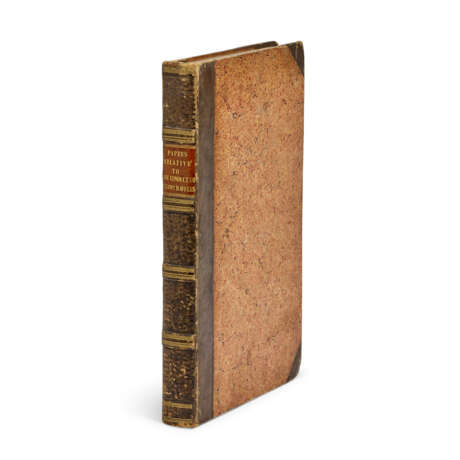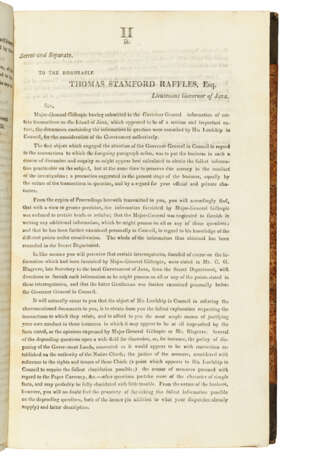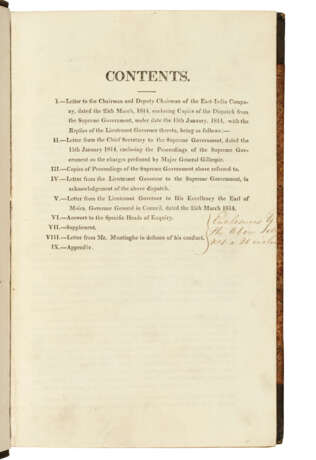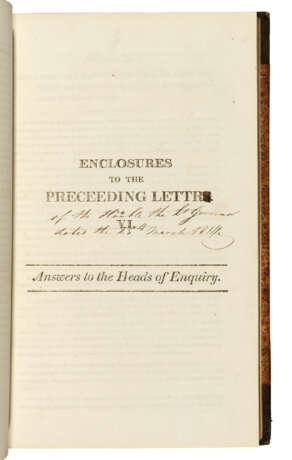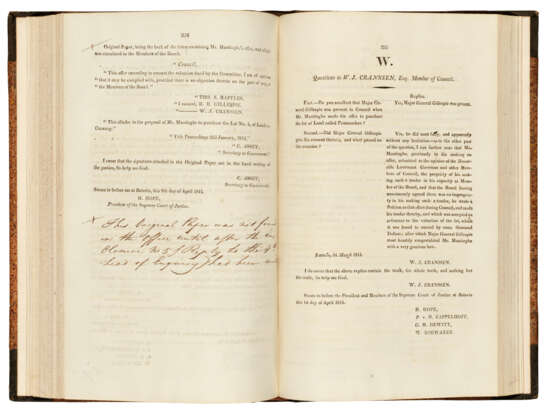ID 870683
Lot 174 | RAFFLES, Sir Thomas Stamford Bingley (1781-1826)
Valeur estimée
£ 2 000 – 3 000
[The charges of Major General Gillespie against The Honourable T. S. Raffles, Leutenant (sic) Governor of the Island of Java, with various papers and documents, in refutation of them relatiing (sic) to the administration of the British Government, in that Island its Dependencies. ?Batavia, i.e. Jakarta: ?Honorable Company's Printing Office, c.1815].
Extremely rare privately printed set of documents relating to the response of Stamford Raffles to the attacks on his administration and financial policy in Java. Extremely rare: we have only been able to trace 3 copies in the British Library (one of which defective, lacking contents leaf), one in Leiden (lacking all after pp.268) and the Bastin copy, described below, in Singapore. We have not been able to trace any copy at auction in the past 50 years (RBH/ABPC).
The global reach of the Napoleonic Wars meant that Raffles mounted a military expedition in 1811 as part of the British campaign against the Dutch colonies in Java that were under French Napoleonic rule. The British military operation was led by Admiral Robert Stopford and Lieutenant-General Sir Samuel Auchmuty, with Colonel Robert Rollo Gillespie conducting the action against the Dutch Governor Jan Willem Janssens at Meester Cornelis (now Jatinegara). Gillespie stormed the fort and captured it within three hours, Janssens fleeing into the interior of the island. The British invasion of Java only lasted 45 days, and the Governor-General of India, Lord Minto, appointed Raffles Lieutenant-Governor of the Dutch East Indies, passing over Gillespie, the military hero. Consequently, Gillespie's relationship with Raffles deteriorated, and Gillespie levelled a number of charges against him, questioning his administration of the island and his practice of selling tracts of land. The East India Company instigated a court of inquiry, and in August 1815, the directors issued a condemnation of Raffles' actions and demanded his recall. Simultaneously, the island of Java was returned to Dutch control following the Napoleonic Wars, under the terms of the Anglo-Dutch Treaty of 1814. In October 1815, the new governor-general, the Marquess of Hastings, further reproved Raffles, and ordered his transfer to the company's ailing west Sumatra residency at Bencoolen. With the death of his patron, Lord Minto, in June 1814, facing the company's criticism and slight, distressed from the death of his first wife and himself suffering from illness, Raffles departed for England in 1816. By 1817 his fortunes had changed: in the spring of that year the directors exonerated him from charges of dishonourable personal motives and confirmed his Bencoolen appointment; Raffles met and married his second wife, Sophia Hull; he started to circulate at court and appear in London society; and he was knighted. In November 1817, Raffles embarked once again for the Far East, this time with Sophia to take up the Bencoolen residency.
The present lot, a single volume consisting of documents relating to the charges levelled against Raffles, does not seem to have ever had a printed title-page, but the title comes from an autograph manuscript title written by Raffles and attached to another copy of this printed work, now in the National Library of Singapore (Bastin Collection, Lee Kong Chian Reference Library, call no. RRARE 353.46095982 CHA). In that same volume is bound an autograph letter by Raffles to the Chairman of the East India Company, dated Batavia, 20 February 1815, stating that he had ‘deemed prudent to print a few private copies of my replies to the charges preferred against my administration and character by Major General Gillespie’. The printing is very similar to Raffles’ Code of Provisional Regulations, for the Judicial and Police Departments which was printed in Batavia (i.e. Jakarta) at the East India Company’s printing office (see Christie’s online sale 20382 ending 28 April 2021, lot 82), and it seems likely the present lot was printed at the same place. The Singapore copy is also bound with Raffles’ Memorial addressed to the directors of the East India Company in 1816, together with a printed Extract from a public letter addressed by the directors to the Supreme Government in Bengal exonerating him of all the major charges made against him by Gillespie.
Folio (306 x 189mm). Erratic pagination thus: [1] (contents, verso blank), i-ii (I. Letter to the Chairman … of the East-India Company … enclosing Copies of the Dispatch from the Supreme Government. Batavia 25 March 1814), iii-iv (II. Secret and separate. Letter from Dowdeswell to Raffles), [2] (III. Part-title Proceedings of His Excellency the right Honorable the Governor General in Council, verso blank), 43-73 [1, blank] (Copies of Proceedings of the Supreme Government), [v-]vi (IV. Part-title Raffles to Dowdeswell), [1] (V. Manuscript part title, verso blank), [1-]21 [1, blank] (Raffles answers), [2] (VI. Part-title Enclosures to the preceeding letters), 77-187 [1, blank], [1] (VIII. Part-title Mr Muntinghe's Letter Enclosure No. 20, verso blank), 25-40, [1] (IX. Part-title, Appendix), 191-373 [1, blank]. (Occasional very faint and insignificant spotting and finger-soiling, some side-notes closely trimmed and just touched by the binder.) Later 19th-century half calf over marbled paper-covered boards (extremities lightly rubbed). Provenance: contemporary ink manuscript part-title, notes and references (some trimmed by the binder).
Special notice
No VAT on hammer price or buyer's premium.
| Lieu d'origine: | Europe du Nord, Asie, Europe, Royaume-Uni |
|---|---|
| Catégorie maison de vente aux enchères: | Livres imprimés |
| Lieu d'origine: | Europe du Nord, Asie, Europe, Royaume-Uni |
|---|---|
| Catégorie maison de vente aux enchères: | Livres imprimés |
| Adresse de l'enchère |
CHRISTIE'S 8 King Street, St. James's SW1Y 6QT London Royaume-Uni | |
|---|---|---|
| Aperçu |
| |
| Téléphone | +44 (0)20 7839 9060 | |
| Commission | see on Website | |
| Conditions d'utilisation | Conditions d'utilisation |
